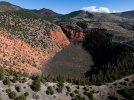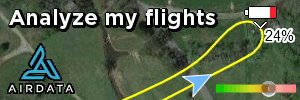You are using an out of date browser. It may not display this or other websites correctly.
You should upgrade or use an alternative browser.
You should upgrade or use an alternative browser.
Air 3 Dotsero Crater
- Thread starter hank970
- Start date
Daniel NZDF
Well-Known Member
Wow, epic!
I have one question - how do you know it erupted 4150 years ago and not less? Radiocarbon dating has its problems...
Radiocarbon dating has its problems...
I have one question - how do you know it erupted 4150 years ago and not less?
4150 years, with a margin of error of 300 years plus or minus, is based on radiocarbon dating of wood buried beneath the ejecta. I'm certainly not qualified to challenge that finding. Are you?Wow, epic!
I have one question - how do you know it erupted 4150 years ago and not less?Radiocarbon dating has its problems...
Daniel NZDF
Well-Known Member
Interesting. I'm not qualified but have done a lot of research in this area. There are three assumptions with this method of dating:
But that's kind of off-topic. I really liked the picture - it looks like a beautiful spot!
- When the rock forms (hardens) there should only be parent radioactive atoms in the rock and no daughter radiogenic (derived by radioactive decay of another element) atoms;
- After hardening, the rock must remain a closed system, that is, no parent or daughter atoms should be added to or removed from the rock by external influences such as percolating groundwaters; and
- The radioactive decay rate must remain constant.
But that's kind of off-topic. I really liked the picture - it looks like a beautiful spot!
Thanks for looking and for the compliment. The area would be more beautiful if not trashed by many of its visitors.Interesting. I'm not qualified but have done a lot of research in this area. There are three assumptions with this method of dating:
That means that those assumptions are what they are - assumptions and therefore can't give accurate dates. We don't know if these assumed things were present at the time when the landform was created.
- When the rock forms (hardens) there should only be parent radioactive atoms in the rock and no daughter radiogenic (derived by radioactive decay of another element) atoms;
- After hardening, the rock must remain a closed system, that is, no parent or daughter atoms should be added to or removed from the rock by external influences such as percolating groundwaters; and
- The radioactive decay rate must remain constant.
But that's kind of off-topic. I really liked the picture - it looks like a beautiful spot!
Carbon-14 dating doesn't apply to the rock but only to surviving organic materials affected at the time of the event, such as vegetation which was extant at the time of the explosion. There are other dating methods for the rock itself (comparison of strontium/rubidium, potassium/argon, uranium/lead isotopes, etc.), but I don't know whether any of them have been used to date ejecta from this particular volcano.
I'm a lapsed geologist (degreed but pursued a different career path) and was accompanied by two other geologists (retired) on yesterdays' trip to the site. None of us is familiar with the latest and greatest rock-dating techniques.
Similar threads
- Replies
- 1
- Views
- 909
- Replies
- 39
- Views
- 2K
- Replies
- 1
- Views
- 894
- Replies
- 5
- Views
- 797
- Replies
- 4
- Views
- 656
DJI Drone Deals
Members online
Total: 3,106 (members: 12, guests: 3,094)











